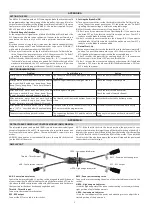
Sinus 912 LSA Glider 550 MTOW
www.pipistrel.eu
REV. 3
Undercarriage
The undercarriage is a tricycle type with two main, brake equipped, wheels mounted on struts and a
steerable nose wheel. The nose wheel steers through rudder pedals
distance between main wheels:
63 inch (1.6 m)
distance between main and nose wheel:
60 inch (1.52 m)
tire:
4,00'' x 6'' (main wh.), 4,00'' x 4'' (nose wh.)
tire pressure
24 psi - 28 psi (main wh.), 18 psi (nose wh.)
brakes:
disk type, driven by brake pedals located on both rudder pedals
brake fluid:
DOT 3 or DOT 4
Beringer high performance brakes with the parking brake is optional equipment. To apply the park-
ing brake, depress the pedal brake levers, hold them engaged and pull the parking brake lever (on
the side of the instrument column in front of the control stick). Then release the pedal brake levers.
To disengage, push the parking brake levers to full forward position.
Seats and safety harnesses
Seats have no stiff internal structure and can therefore be folded easily for luggage access. The seat
has one position, whereas the pedals are adjustable. Custom made seats are available for ordering.
All Sinus 912 LSA ship with H type safety harness attached to the fuselage at three mounting points.
Pitot-Static tubes
The pitot tube is attached to the bottom side of the right-hand wing. Pitot lines made of plastic
materials lead through the inside of the wing all the way to the instrument panel. Pitot heat and an
AOA-indication pitot are optional
Air brakes
Air brakes are most commonly used to increase drag and steepen the final approach. They are stan-
dard equipment on the Sinus 912 LSA. Airbrakes make the total landing distance equivalent to the
total take-off distance, enabling you to use STOL runways for your operations.
During takeoff, climb and cruise air brakes MUST be retracted and locked (handle in cockpit in full up
position). To unlock and extend air brakes, press on the release lever and pull the handle downwards
Description of Aircraft & Systems
7-6
















































